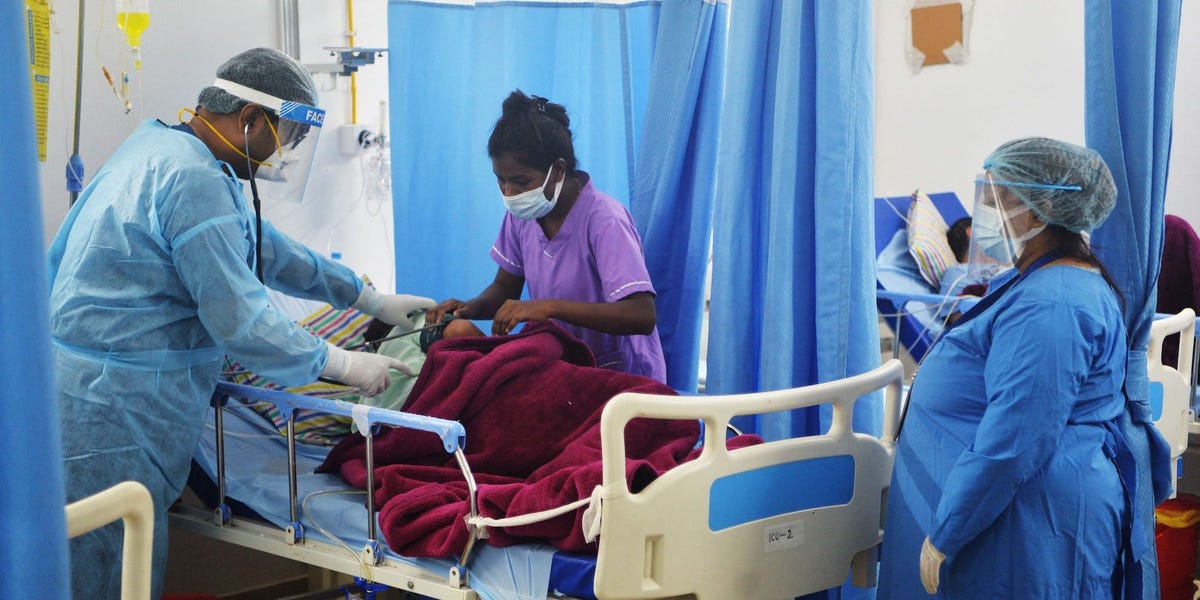- WHO estimates that there could be an 18 million healthcare worker shortage worldwide by 2030.
- Healthcare workers across the globe are struggling with their mental health, an expert said.
- Vaccine equality could help relieve mental health burdens and keep workers in the health industry.
- See more stories on Insider’s business page.
Vaccine inequality across the globe is impacting the mental health of healthcare workers, which could further contribute to worker shortages across the globe, a former CDC director said.
Dr. Tom Kenyon, a former director of the Center for Global Health, and current Chief Health Officer for Project Hope told Insider that healthcare workers across the world are struggling with their mental health amidst the pandemic, whether it be new anxiety or depression or simply worsening conditions as they continue to treat patients.
Project Hope launched Mental Health & Resiliency Trainings for health care workers, in Indonesia, the Dominican Republic, and the Philippines last summer to help those on the frontlines of the pandemic navigate the pressures that could lead to negative mental health outcomes.
A global lack of vaccines is making the problem worse
Kenyon said while the strain of the pandemic is easing for workers in the US as more and more people get vaccinated, the lack of vaccinations available to health workers in developing countries is stretching out the pandemic and negatively impacting mental health.
“We’re not looking at anytime soon that the rest of the world would be vaccinated. There’s kind of two worlds right now, our world, which is getting ready to open up and ‘normalize’, and the low-income country world where that’s not even on anyone’s radar,” Kenyon said last month. “They just don’t have a vaccine. I think we’ll, we’ll be lucky if we reach 10% global vaccine coverage by end of the year.”
Enough doses have been given to 12.5% of the global population, but according to Bloomberg’s tracker, the bulk of those have been in wealthy countries where populations are getting vaccinated more than 30 times faster than in lower-income countries. While more than 46% of the population in US is fully vaccinated, only 2.4% of the population in the Philippines is vaccinated as of June 1.
He explained that having people vaccinated not only eases the strain and worry healthcare workers have about their own health and the risks they pose to their families, but it would also reduce the caseload and morbidity they’re exposed to.
“What’s so different about COVID is it’s affected your life at home, as well as you’re in the workplace and your life outside the hospital. Whereas if you’re dealing with let’s say an Ebola outbreak or a flu pandemic or something like that, that’s historically has been more in the health facility and not spilled over so much into their personal lives,” Kenyon told Insider.
“Also this whole issue of taking the disease home and not having a vaccine. The countries we’ve been working with haven’t been vaccinated yet. I think it will be interesting to see how that lifts a heavy load off of people’s shoulders when they get vaccinated.”
The parallels between COVID-19 and the early days of the AIDS epidemic
Kenyon, who spent years working in countries as principal deputy global AIDS coordinator and chief medical officer for the President’s Emergency Plan for AIDS Relief (PEPFAR) in the Department of State, said he saw parallels between what healthcare workers are experiencing now and what those who worked at the start of the AIDS pandemic saw.
He explained that with morbidity and death, health workers were less encouraged to keep working, especially on patients they couldn’t help. The constant death and their inability to save lives led to low morale about the job on top of the impact it had on their own mental health.
“The mortality was staggering. You go home at night and come back and there are five patients who died during the night waiting to be carted off of the ward. A lot of health workers walked away at that point. Some said ‘I’m just not going to treat patients with HIV.’ Then in the early two-thousands treatment became available and that suddenly changed,” he said. “It suddenly became very gratifying to treat HIV. So I think with better interventions in addition to vaccines, better therapies…that will help a lot with the mental health trauma that workers experience.”
The World Health Organization estimated that globally there could be a shortfall of 18 million health workers by 2030, mostly in low- and lower-middle-income countries.
The pandemic has already strained healthcare workers both in the US and abroad. In the US, recent studies show somewhere between 20% and 30% of frontline healthcare workers are considering leaving the profession, and a report by the British Medical Association found that thousands of doctors in the UK plan to leave the profession.
Kenyon said that trend could be seen worldwide making it critical to take the load off current healthcare workers so as not add to the potential shortfall.
“They just don’t feel supported and they don’t feel like anyone cares about them. They just feel taken for granted… It’s pretty frightening what level of the health workforce has contemplated leaving the health profession,” he said.
Source: Read Full Article





